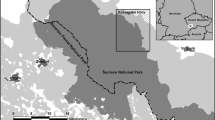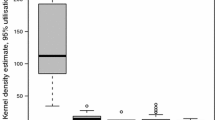Abstract
The use of habitat by female and male adult capercaillie Tetrao urogallus during summer and autumn was studied by comparing the distribution of radio locations of birds with the availability of habitat at forest stand, home range and landscape level in an area of the Bavarian Alps, Germany. Capercaillie preferred forests with structural features typical of their main distribution range, the boreal forest: they selected large patches of old forest with moderate canopy cover of about 50%, and a well developed field layer with high proportions of bilberry Vaccinium myrtillus. Hens selected both home ranges and sites within home ranges in old forest. Ranges selected by cocks did not differ from availability in the study area, but they preferred old forest within their ranges. The size of home ranges was negatively related to bilberry cover both in hens and cocks. The distribution of bilberry also determined habitat use by capercaillie at the landscape scale. The study demonstrated that bilberry is the major determinant of the selection of habitat by capercaillie in landscapes with sparse and fragmentary cover of ericaceous shrubs, such as central Europe.
Similar content being viewed by others
References
Aerts R, Berendse F (1988) The effect of increased nutrient availability on vegetation dynamics in wet heathlands. Vegetatio 7: 63–69
Biedermann R (1992) Arthropodenvielfalt und Auerhuhn-Nahrung in den emissionsgeschädigten Hochlagen des Bayerischen Waldes. Thesis, Univ. Regensburg, Germany
Eiberle K (1976) Zur Analyse eines Auerwildbiotops im Schweizerischen Mittelland. Forstwiss Centralbl 95: 108–124
Ellenberg H (1983) Gefährdung wildlebender Pflanzenarten in der Bundesrepublik Deutschland. Forstarchiv 54: 127–133
Ellenberg H (1992) Eutrophication and its consequences for habitat, species and conservation. Grouse News 3: 5–7
Fretwell SD (1972) Populations in a seasonal environment. Princeton University Press, Princeton
Fretwell SD, Lucas HL (1970) On territorial behavior and other factors influencing habitat distribution in birds. I. Theoretical development. Acta Biotheor 19: 16–36
Glutz von Blotzheim UN (1973) Handbuch der Vögel Mitteleuropas 5. Akademische Verlagsgesellschaft, Frankfurt am Main
Gjerde I (1991) winter ecology of a dimorphic herbivore: temporal and spatial relationships and habitat selection of male and female capercaillie. Phd thesis, Univ Bergen, Norway
Hansson L (1992) Landscape ecology of boreal forests. Trends Ecol Evol 7: 299–302
Helminen M (1963) Composition of the Finnish population of capercaillie and black grouse in the autumn of 1952–61, as revealed by a study of wings. Finn Game Res 23: 1–124
Högbom L, Högberg P (1991) Nitrate nutrition of Deschampsia flexuosa in relation to nitrogen depositon in Sweden. Oecologia 87: 488–494
Jacob L (1987) Le régime alimentaire du grand tétras: synthese bibliographique. Gibier Faune Sauvage 4: 429–448
Klaus S, Boock W, Görner M, Scibt E (1985) Zur Ökologie des Auerhuhns in Thüringen. Acta Ornithoecol 1: 3–46
Klaus S, Andreev AV, Bergmann HH, Müller F, Porkert J, Wiesner J (1986) Die Auerhühner. Die Neue Brehm-Bücherei. Ziemsen, Wittenberg Lutherstadt
Krebs CJ (1989) Ecological methodology. Harper and Row, New York
Leclercq B (1987) Influence de quelques pratiques sylvicoles sur la qualité des biotopes à grand tétras dans le massif du Jura. Acta Oecol 8: 237–246
Müller F (1974) Territorialverhalten und Siedlungsstruktur einer mitteleuropäischen Population des Auerhuhns. PhD thesis, Univ. Marburg, Germany
Neu CW, Byers CR, Peek JM (1974) A technique for analysis of utilization-availability data. J Wildl Manage 38: 541–545
Porkert J (1982) Zu den Veränderungen der Struktur der Rauhfusshühner-Biotope in den Kammlagen des Ostteils der Sudeten und ihres Zusammenhanges mit den im Niederschlagswasser transportierten Schadstoffimmissionen. Opera Corcontica 19: 165–182
Rolstad J (1988) Autumn habitat of capercaillie in southeastern Norway. J Wildl Manage 52: 747–753
Rolstad J (1989) Autumn movement and spacing of adult and subadult common capercaillie in relation to social behaviour and habitat. In: Rolstad J (1989) Habitat and range use of capercaillie in southcentral Scandinavian boreal forests. PhD thesis, Agricultural University of Norway
Rolstad J, Wegge P (1987) Size and spacing of capercaillie leks in relation to old forest fragmentation. Oecologia 72: 389–394
Rolstad J, Wegge P (1989) Capercaillie habitat: a critical assessment of the role of old forest. Proc Int Grouse Symp 4: 235–249
Rolstad J, Wegge P, Larsen BB (1988) Spacing and habitat use of capercaillie during summer. Can J Zool 66: 670–679
Rosenzweig ML (1985) Some theoretical aspects of habitat selection. In: Cody ML (ed) Habitat selection in birds. Academic Press, Orlando
Scherzinger W (1974) Interpretation einer Bestandesaufnahme an Auerhühnern im Nationalpark Bayerischer Wald. Allg Forst Z 29: 828–829
Schwarzmüller C (1990) Nahrungswahl von Auerhühnern. Diplom thesis, Univ Munich, Germany
Seiskari P (1962) On the winter ecology of the capeercaillie and the black grouse in Finland. Pap Game Res 22: 4–119
Stein J (1974) Die qualitative Beurteilung westdeutscher Auerhuhnbiotope unter besonderer Berücksichtigung der Grenzlinienwirkung. Allg Forst Z 39: 837–839
Storch I (1993a) Habitat use and spacing of capercaillie in relation to forest fragmentation patterns. PhD thesis, University of Munich, Germany
Storch I (1993b) Patterns and strategies of winter habitat selection in alpine capercaillie. Ecography 16: (in press)
Storch I, Schröder W (1990) Kriegt der große Hahn die Kurve? Ein Schutzkonzept für das Auerwild. Allg Forst Z 12–13: 310–312
Storch I, Schwarzmüller C, Stemmen D von den (1991) The diet of the capercaillie in the Alps: a comparison of hens and cocks. Trans Int Congr Union Game Biol 20: 630–635
Wegge P, Larsen BB, Gjerde I, Kastdalen L, Rolstad J, Storaas T (1990) Natural mortality and predation of adult capercaillie in southeast Norway. Proc Int Symp Grouse 4: 49–56
Widén P (1985) Population ecology of the goshawk in the boreal forest. PhD thesis. Uppsala University, Sweden
Zeimentz K (1981) Übersicht der Auerhuhnvorkommen in Bayern. In: Bayerisches Staatsministerium für Ernährung, Landwirtschaft und Forsten (eds) Auerwild. Schutz und Hege im Staatswald Bayerns. Munich, pp 3–7
Author information
Authors and Affiliations
Rights and permissions
About this article
Cite this article
Storch, I. Habitat selection by capercaillie in summer and autumn: Is bilberry important?. Oecologia 95, 257–265 (1993). https://doi.org/10.1007/BF00323498
Received:
Accepted:
Issue Date:
DOI: https://doi.org/10.1007/BF00323498




